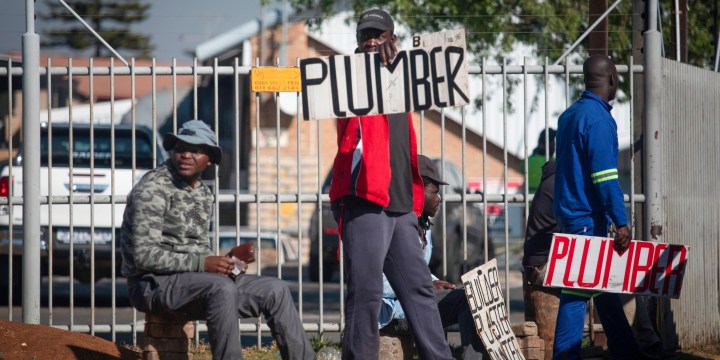AFRICA CHECK ANALYSIS
Declining unemployment figures in SA are good news, but context, as always, matters

The ANC is correct that unemployment has decreased for seven consecutive quarters, but there is more to the story.
With national elections approaching in 2024, South Africa’s ruling party, the African National Congress (ANC), is keen to promote its record. It recently launched a review of the promises made in its 2019 manifesto.
On 4 September 2023, the day of the ANC’s review rally, secretary general Fikile Mbalula posted a graphic to X (formerly Twitter) claiming that under the party’s rule, unemployment had decreased “for seven consecutive quarters since 2021”. When some of our readers asked us to look into the claim, we pulled up the figures.
Measuring unemployment in South Africa
There are several ways to measure unemployment, including looking at the number of unemployed people, the official rate of unemployment, and an expanded version of the unemployment rate.
Dr Bianca Chigbu researches labour and employment in South Africa and lectures sociology at the University of Fort Hare in the Eastern Cape province. She told Africa Check that while the number of unemployed people can be useful, this indicator doesn’t account for changes in the size of the labour force. Unemployment rates, which show the percentage of the labour force that is unemployed, give a more accurate picture of trends over time, Chigbu said.
ANC head of policy Fébé Potgieter told Africa Check the claim was based on the expanded definition of unemployment. This includes unemployed people who are not actively looking for work (“discouraged job-seekers”, and people not looking for other reasons, like living too far away from potential jobs).
Read more in Daily Maverick: SA jobless rate dips slightly in Q2, but is still sky-high at 32.6%
Although some researchers have argued that the expanded definition of unemployment may introduce subjectivity in measurement, it is considered an important and possibly more stable indicator.
By this measure, the claim is correct. The expanded unemployment rate decreased across seven consecutive quarters, from 46.6% in the third quarter of 2021 to 42.1% in the second quarter of 2023.
Labour market variables
Unemployment rates are useful measures of unemployment, especially over time, Chigbu told Africa Check, but “numerous labour market variables must be considered for a thorough understanding of employment dynamics”.
For example, according to Statistics South Africa, the country’s data agency, underemployment is also a significant challenge. This is where people are counted as employed, but for fewer than the typical working hours in a week, and want to increase their time in employment.
StatsSA also reports the number of young people not in employment, education or training (Neet). According to the South Africa Labour and Development Research Unit, “young people who are Neet are arguably the most vulnerable group in the labour market”. StatsSA reported that in the second quarter of 2023, 43.4% of young people aged 15 to 34 were classified as Neet.
The trouble with quarters
Despite the claim being correct, there is more nuance to the story.
One issue is that the claim compares quarters within the same year to one another. This “can be deceptive because economic conditions vary seasonally” due to factors like “holidays, disruptions such as Covid, or industry-specific patterns”, Chigbu told Africa Check. For example, some industries hire more people during particular quarters or see layoffs.
Comparing rates over multiple years is more accurate and informative, Chigbu said. “It is usual practice to compare the same quarter over different years to provide a more accurate assessment” because it allows us to understand long-term trends.
Zooming out — a general decline?
When looking at the last seven quarters, there has been a general downward trend in unemployment rates. But if we zoom out to look at overall trends across multiple years, we see that unemployment rates before this had largely been on the rise.
One exception was a sharp dip in the official rate when the Covid-19 pandemic started. But according to the World Bank, this was a temporary trend, the result of people not being able to actively look for work and data collection issues.
Longer-term trends show that the seven consecutive quarter decrease came after a historic peak in unemployment rates in 2021, which saw the highest expanded unemployment rate (46.6% in quarter three) and official unemployment rate (35.3% in quarter four) since StatsSA started collecting this data in 2008.
We asked Chigbu about these trends. Although the recent decline in unemployment rates was a “welcome development”, the high unemployment rates before this period put this brief decline into perspective, she said.
When talking about unemployment in South Africa, the country’s “history of high unemployment and the specific factors causing these changes” should be taken into account, Chigbu said. “Addressing the underlying causes of unemployment remains a critical task for policymakers in order to achieve long-term labour market reforms.”
Conclusion: Correct that unemployment rate decreased over seven consecutive quarters, but doesn’t show full picture of joblessness
In a graphic shared to social media, ANC secretary general Fikile Mbalula claimed unemployment in South Africa had decreased for seven consecutive quarters.
Based on the expanded definition of unemployment, which includes discouraged work seekers, the claim is correct.
However, an expert warned that comparing results from consecutive quarters can be misleading. Longer-term data shows that the recent decline in unemployment came after record highs. DM
First published by Africa Check.

















 Become an Insider
Become an Insider
Comments - Please login in order to comment.